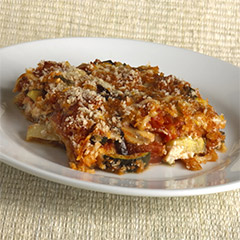 February is American Heart Month, the perfect time to give yourself some “TLC” and take your cardiovascular health to heart. One simple step? Follow a heart healthy diet.
February is American Heart Month, the perfect time to give yourself some “TLC” and take your cardiovascular health to heart. One simple step? Follow a heart healthy diet.
Changing your eating style is one the simplest ways to reduce your risks of serious disease and disability—and with our tips plus a special recipe, you can do it deliciously!
Making Heart Healthy Work for You
You can best serve your heart health with a diet that consists of plenty of plant foods and lean proteins, as well as by choosing healthy fats and whole grains. It’s best to limit sweets, sodium, and junk food in general, plus avoid trans fats.
Heart healthy is basically… healthy! The American Heart Association (AHA) guidelines for a healthy diet offers several specific tips that can make a big difference in reducing your risk factors for cardiovascular disease. Mostly, it’s about eating natural, wholesome foods.
Here are a few key AHA recommendations for a heart healthy diet, and tips on how to make them work for you. And you can try out a tasty example, a recipe for an Eggplant, Cheese and Tomato bake, as the perfect center of a heart healthy meal.
- Eat plenty of fruits and vegetables. The brighter the color, the better: green, orange, yellow and red and blue are all indicators of some of the healthiest foods you can eat to protect your heart.
Dark leafy green veggies like spinach and kale slip into one-pot dishes like soups and stews with no trouble. Adding frozen blackberries and raspberries to you smoothies will give them flavor, color and fiber too! Yellow and orange bell peppers make a great substitution for chips with your favorite yogurt dip.
- Choose whole grain foods. Subbing out whole grains for other types of grains is simple if you know how to read the packages. For instance, “whole wheat” bread isn’t necessarily whole grain bread: look for “100% Whole” as the designation.
For other foods, “whole grain” will be spelled out, but check how much there is of it in the ingredients list. You’re aiming for 3 servings a day on the heart healthy diet. A packaged granola bar might contain oats, which are whole grain, but not enough to make it a full serving of whole grains.
- Choose fish, lean meats and alternatives. The idea here is to limit the amount of saturated fat you eat, which can be high in meat servings, especially with more marbled and fattier cuts. Meatless Mondays and Fish on Fridays are two ways you can alter your weekly meal schedule to support your heart health.
Leaner meats include poultry without the skin and pork trimmed of fat. Alternatives can give you a chance to include more Omega 3 fatty acids in your diet while meeting your need for protein servings. Try walnuts or wild-caught salmon on top of your chef salad.
- Strictly limit the amount of trans fats you eat. Some fat in your diet is good for you, like the unsaturated fats derived from plant foods such as avocado or olive oil. But another category of fat, trans fats—is known to negatively affect your blood cholesterol levels, which can damage your heart health.
One way to avoid trans fats is to look for mention on menus and packages. “No trans fats” does not necessarily indicate heart healthy food, but it’s a start. For example, fried foods cooked in hydrogenated vegetable oil, or pastries made with shortening contain trans fats. Eating french fries and candies labeled “no trans fats” does not make for a heart healthy diet!
- Limit sodium. The majority of sodium in the average diet comes from processed or packaged foods. Added table salt as a seasoning can be a culprit, too—and studies have shown that restaurant meals tend to contain more sodium overall than dishes you prepare at home.
So, you can typically limit your sodium intake by limiting how often you eat food that others have prepared for you! For example, cooking your own batch of soup with low-sodium broth can save you hundreds of salt grams over choosing a can of soup off the shelf. And be wary of adding salt to meals you order out—chances are, they are well-seasoned already.
- Limit added sugar. Soda pop and other sweetened drinks (like lemonade mix for example) are a great place to start reducing your intake of added sugar. It’s also time to reign in your sweet tooth—saving special treats for special occasions is a good rule of thumb.
Because of the natural sugars found in fruits, many people find sweet melons, berries, and tree fruits like peaches and plums, to be a heart healthy substitute for sugary snacks and desserts.
Eggplant, Cheese and Tomato Bake
Colorful veggies and mushrooms instead of meat sauce add to the heart healthy yum factor for this Mediterranean-inspired baked dish, adapted from The American Heart Association website.
Ingredients

- 1 large sliced eggplant (about 17-20 slices)
- 1 medium thinly sliced onion (about 2 cups), cut into bite-size strips
- 2 zucchini (about 2 cups), cut into bite-size pieces
- non-stick cooking spray
- 2 tsp. extra virgin olive oil or canola oil
- 3 cups mushrooms, sliced
- 3 cloves minced garlic OR 3 tsp. fresh, minced garlic
- 2 Tbsp. water
- 1/4 tsp. black pepper
- 29 oz. canned, no salt added, diced tomatoes
- 8 oz. canned, no salt added tomato sauce
- 3 Tbsp. fresh, chopped basil OR 1 Tbsp. dried basil
- 3/4 cup part-skim, low-fat ricotta cheese
- 1 cup low-moisture, part-skim mozzarella cheese, shredded
- 1 cup 100% whole wheat bread crumbs
Directions
Preheat oven to 375° F
Arrange eggplant, onions and zucchini on a baking sheet, sprayed with cooking spray. Lightly spray top of vegetables with cooking spray as well. Cover with aluminum foil.
Bake for 10 minutes covered and 10 minutes uncovered.
In a small saucepan, heat extra virgin olive oil over medium heat, sauté mushrooms and garlic with water and pepper, until mushrooms begin to soften, about 6 minutes. Add diced tomatoes, tomato sauce and basil, reduce heat and simmer for 10 minutes.
Spread 1/2 tomato-mushroom mixture on bottom of a 9×13 baking dish coated with cooking spray. Then layer half of the eggplant, zucchini and onion. Layer all of ricotta, and sprinkle a layer of half the mozzarella
Repeat layers with another 1/2 of tomato-mushroom mixture and the remaining eggplant, zucchini and onion. Add the remaining tomato mixture, evenly sprinkle the remaining mozzarella and top with breadcrumbs.
Bake for 30-45 minutes or until most of the liquid has disappeared and cheese begins to brown. Let cool for 10 minutes before cutting and serving.


